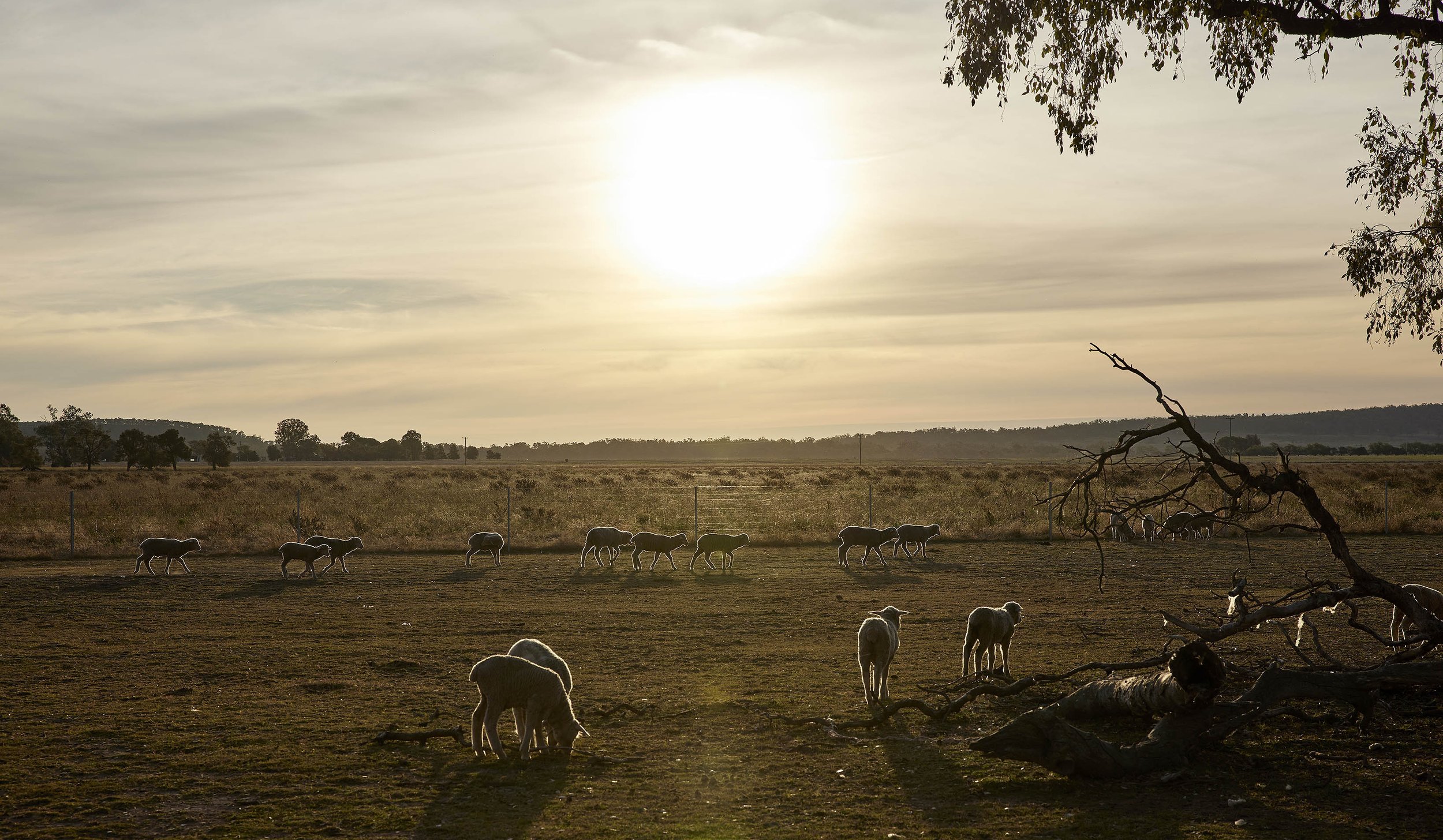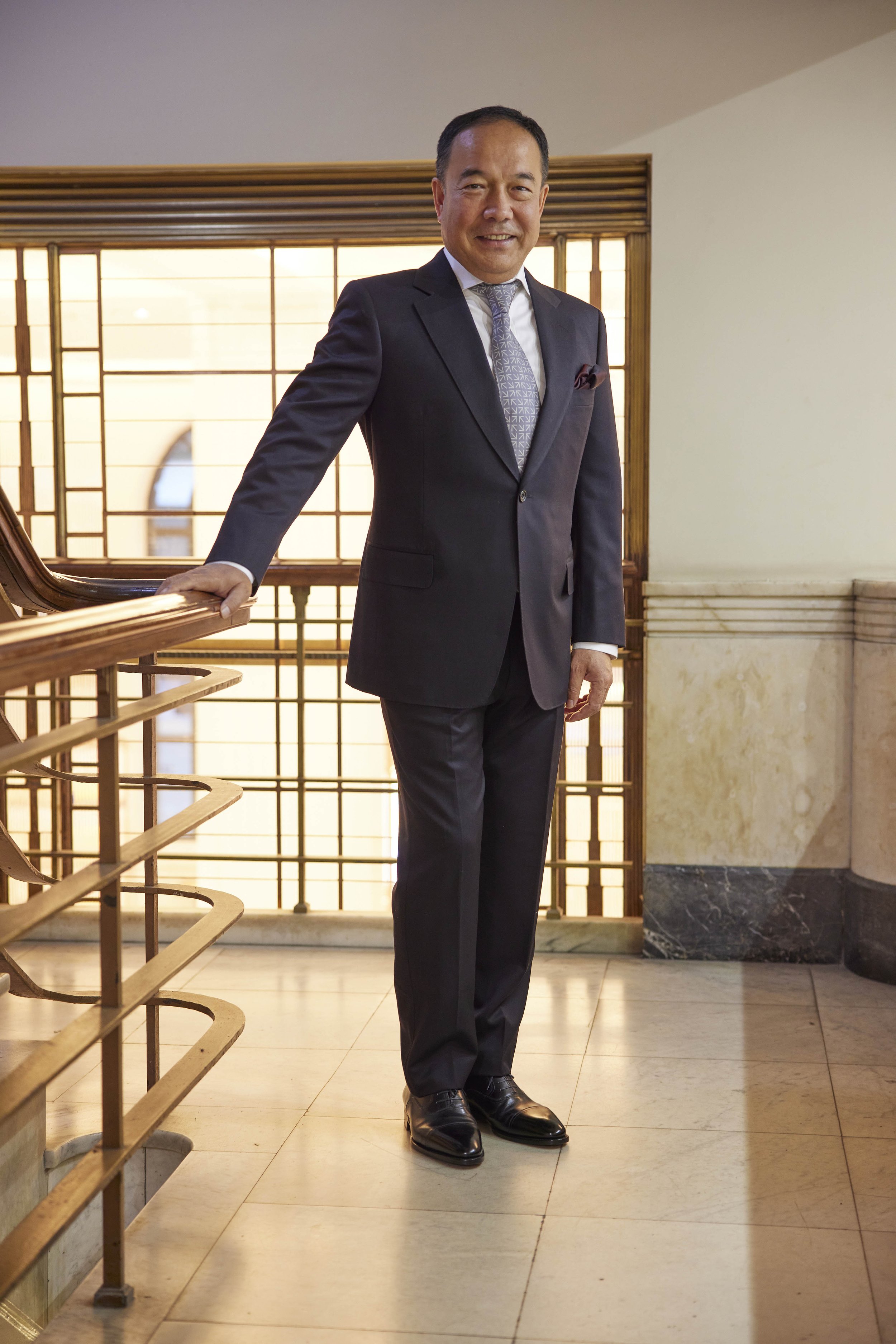Sheep graze peacefully on Floyd Legge’s farm in Cudal, New South Wales, Australia. Photo by Richard Weinstein
It’s often said a prophet is not accepted in their hometown. That’s doubly the case in Australia. This country has some of the world’s best products and produce. But they often go unrecognised in our own backyard.
Wool is one of them.
I recall a visit to Rome where I spent several enjoyable hours window shopping near the Spanish Steps. I looked in the many menswear shops on Via Condotti with their beautiful seasonal displays – magnificent suits, patterned sports coats, striped scarves.
And there it was.
Nestled amongst an array of colourful fine knitwear, written in Texta on small white cards, were the words “Super Geelong” and “Super Tasmanian”.
The wool on these sheep’s backs become luxury suiting. Photo by Richard Weinstein
Not “Made in Italy”. Not “Finest Cashmere”. Not even “100% Wool”.
My heart soared. The names of places from my homeland – places I knew well and had visited – writ large before me.
Merchants in Italy promote these words because their educated customers – who revere high-quality clothes – recognise and respect them. Above all, these words sell product.
Sheep are sheared of their fleece before it is processed into luxury cloth. Photo by Richard Weinstein
Super Geelong and Super Tasmanian are bywords for finest quality wool used in the most exclusive, most expensive apparel. Really, the terms mean “Australian wool”. And Australian wool is the best money can buy.
Many places around Australia produce world-class wool, of course, including Forbes, New South Wales, 500 kilometres west of Sydney. It is here something truly special is happening in the sphere of Australian wool.
One of the unfortunate truths of Australia’s 250-year wool story is that, while our farmers produce the best – and the most – wool in the world, local industry has never geared itself up for processing this wool into the high-quality yarn or cloth used by the textiles and fashion industries.
Those superfine jumpers I lusted after in Rome may have been made from Australian wool, but they weren’t “Made in Australia”. Likewise, the woollen cloth tailored into $10,000 suits on London’s Savile Row.
It’s a missed opportunity. But there is one Australian producer determined to change that. One suiting length at a time.
Wool is natural and sustainable. Photo by Richard Weinstein
Thirty-six-year-old Floyd Legge is a sixth-generation farmer whose family wool business stretches back 150 years. Floyd and his sisters, Ruth and Isabele, run RB & JF Legge.
The Legges produce superfine merino sheep. Their young sheep’s wool is measured at around 16-to-17 microns – adult sheep are around 18 microns. The lower the number, the finer the wool and, potentially, the more valuable it may be. For comparison, human hair is around 70 microns.
The story of Floyd’s family farming history in Australia began with the purchase of the “Alexlea” sheep and cattle farm in Dutson, near Sale, Victoria, in 1852 by Floyd’s great-great-great-grandfather, John McNaughton.
Born in Ayrshire, Scotland in 1788, John and his wife Isabella had eight children and, sometime between 1836 and 1843, migrated to Australia. Son, Alexander, took over the running of Alexlea upon John’s death in 1859.
Alexander and his wife, Mary, had 13 children. Their daughter, Isabella, married Samuel Legge in 1892. Samuel and Isabella took over the running of Alexlea and produced 11 children, one of which was Floyd’s grandfather Oswald, born in 1896.
The first man to enjoy a bespoke JH Cutler creation made from the Australian grown and processed product, Radil Arman, inspects the raw material. Photo by Richard Weinstein
After fighting in Egypt and helping liberate Villers-Bretonneux in France during World War One, Oswald returned to Australia, farming on Alexlea and shearing sheep around Victoria and as far away as Longreach, Queensland. He married in February 1922, but widowed four months later.
After re-marrying, Oswald and new wife, Florence, bought a block of land at Nicholson, east of Bairnsdale, and drove some of the merino sheep from Alexlea to their new block.
‘They arrived expecting good pastures, only to discover all the feed had been eaten, so they drove the stock along the roadsides to feed them. They took the sheep to Florence’s father’s property, “Leaside”, in Forge Creek, for shearing,’ Floyd said.
Florence’s father eventually gave the couple 400 acres of land off the corner of Leaside. They called the parcel of land “Ridgehaven”. There they settled with the merino sheep and a handful of dairy cows. They produced one child in 1937, Floyd’s father, Ronald.
Ronald worked alongside his parents on Ridgehaven and, in 1965, he started Ridgehaven Poll Dorset Stud with the purchase of Poll Dorset Ewes. This has now grown into a significant part of the current family business.
Ronald married Jessie McRae, who grew up on a merino sheep and beef cattle farm at Buchan, Victoria. Not long after they married, they purchased Leaside.
Ronald worked in a farming partnership at Ridgehaven with his parents while also running Leaside as a separate business. Oswald died in 1978 and Florence continued to live at Ridgehaven until she died in 1985. Ronald and Jessie then took over running Ridgehaven and Leaside as one business. They had five children, four daughters – Ruth, Margaret, Isabele, and Melinda – and one son, Floyd.
The bulk of the business moved to Cudal in central-west NSW in 1993, along with the Poll Dorset Stud and Hereford cattle.
Radil Arman is his JH Cutler bespoke single-breasted suit, built from the wool provided by Floyd Legge. Photo by Richard Weinstein
‘After the sale of Leaside we were able to lease the farm back to continue running the merino flock. In 2005 we purchased a property in Forbes where we were running some sheep and cattle,’ Floyd said.
Floyd and his sisters Ruth and Isabele continued the farming partnership after their father died in 2007, running Ridgehaven Poll Dorset Stud, along with the merino flock. The siblings leased another property at Forbes in 2009 and moved the merino flock from Bairnsdale to Forbes. It’s a very different climate from eastern Victoria, but the genetics and wool type have remained the same.
Sheep are at the centre of this story. And only the best will do.
‘We run the Roseville Park bloodline. We have been buying them for at least 40 years. They are a traditionally crimped waxy wool, with white bright characteristics,’ Floyd said.
Most of Floyd’s fine wool merino goes to Europe. Brokering the deals is New England Wool, based in Australia, buyer for Reda, and the storied Vitale Barberis Canonico, established in 1663.
Floyd is a wool man through and through. But it was an overseas trip in 2018 and his impending wedding six months later that led him to become a “man of the cloth”, too.
‘I was in China on an Australian Wool Innovation Young Grower trip when I met a young Australian tailor at the airport. We got talking about both ends of the wool process and this sparked my interest in producing an Australian-made cloth,’ Floyd said.
‘I wanted to wear my own wool at my wedding. But a month out from the wedding, my suit was still a thread.’
Floyd learned that, to turn the fleece from his sheep’s backs into a world-class product worthy of the catwalks of Paris and Milan, and the finest luxury stores in New York and London, he needed the expertise and cooperation of many people.
From sheep to suit, the story is immense.
From the Legge farm the wool goes to a store in Parkes, NSW, for core testing, then it’s scoured (washed) in Geelong and carded and combed at Cashmere Connections in Bacchus Marsh, both in Victoria. By this stage, Floyd has pure new wool, with no impurities. The wool is then produced as a sliver, a rope – called “wool top”. This is air freighted to Xinao in China and prepared and spun into yarn. It returns to Geelong for dying and processing to reinstate the feel and softness lost after the dying process. Geelong Textiles weaves the wool. Geelong Dying dyes it.
And – voila! – a length of world-class 220-gram Super 140s cloth is spun and woven and immaculately presented in carefully folded rolls. But who is going to take the cloth and make clothes worthy of this material?
From stage left enters John Cutler OAM.
John is a 72-year-old bespoke tailor who operates his business, JH Cutler, from King Street in Sydney’s CBD.
His family story is equally amazing.
JH Cutler is an Australian institution. Founded in 1884, the venerable tailoring firm outdates many of the famous sartorial and fashion houses – Anderson & Sheppard (1906), Prada (1913), and Gucci (1921), to name but a few.
Fourth generation tailor, John Cutler conducts a fitting in his Sydney rooms. Photo by Richard Weinstein
The story begins in the English Midlands in the 1850s, when engineer Joseph Handel Cutler was – along with thousands of other fortune seekers – beguiled by the township of Ballarat, near Melbourne, where more gold has been found than any other place on earth. He packed up the family and shipped them to the other side of the world, finding work servicing the needs of Victorian Gold Rush prospectors.
Joseph’s oldest son – also Joseph Handel – surprised everyone when he boarded a Cobb & Co coach and travelled north to Sydney. He, at first, worked for others, carving out a career as a respected cutter, before founding the company that survives today in 1884, setting up his first rooms in fashionable King Street. As the city grew, so too did the business, which in the early 1900s moved to new premises in nearby Bligh Street, the heart of the city’s financial hub. By this time, Joseph’s son, Leslie, a sought-after cutter, worked alongside his father.
Leslie’s son, Bruce, returned from London in 1939 – where he had been studying the trade – to defend Australia in the New Guinea campaign. He resumed managing the family business after the war.
John Handel Lawson Cutler, the current Managing Director, is the fourth generation of tailoring Cutlers. A Sydney Grammarian, he joined the family business at 16. Even before then he had shown great interest in the trade, spending many hours in the workshop observing the skilful cutting and sewing of garments for Sydney’s elite businessmen, politicians, entertainers, and wealthy arbiters of bespoke clothing.
John travelled to London at 18 – like his father and grandfather before him – to immerse himself in the trade. He worked at Dormeuil Frères learning about fine fabrics and studied at the Tailor & Cutter Academy, graduating in 1969. John later returned to Sydney and worked alongside his father, Bruce, becoming Managing Director of the family business in 1976, upon his father’s retirement.
The inaugural edition of Courvoisier’s Book of the Best – a trusted compendium for the stylish jet set – cited JH Cutler as being amongst the world’s leading tailoring houses. Several international lists name JH Cutler as one of the world’s 10 best tailors.
But it was in late 2005 when John’s profile launched into the stratosphere upon the completion of what was to become a high-profile commission from a loyal Canadian customer: a vicuna overcoat of the most exquisite quality – with a price tag to match. The $50,000 magnum opus made worldwide headlines and became the subject of an entire book, The Coat Route: Craft, Luxury, and Obsession on the trail of a $50,000 coat by American author, Meg Lukens Noonan.
John and JH Cutler have been the subject of two books: The Coat Route and Making the Cut: The Power behind a Tailoring Dynasty.
Now, John Cutler and Floyd Legge will write a new story, worthy of their separate – and now joint – histories.
‘After having the wool turned into my wedding suit, I looked for opportunities to retail the fabric to a tailor that was interested in a full provenance story from farm to customer. I asked people that know the luxury market and high-quality fashion, and they all recommended John Cutler. I called John and introduced myself, my business, and my story.
Radil Arman, left, John Cutler, centre and Floyd Legge with the sheep that provided the superfine wool. Photo by Richard Weinstein
‘I explained the story, and it sparked John’s interest. I could see that John had a passion for Australian products and Australian-made products. His business was 137 years old, and he could see that our business stretched back 150 years. He asked me to post him a small strip of cloth. I did that and things went from there,’ Floyd said.
Floyd has learned that it’s best to start small. He has had a modest 120 metres of cloth woven and processed for his first attempt. Half of the cloth was dyed black, the other half a specific shade of navy. It is all destined for custom-made suits. John Cutler has already built several black dinner suits for his bespoke customers, and the result is magnificent.
‘The cloth produced by Floyd is the equal of anything of its type produced overseas. It’s lovely to work with and the black and navy-blue material will make very fine formal wear and lounge suits,’ John said.
John built the first suit – a black lounge suit – for Radil Arman. His son, Harvey, became a JH Cutler customer after receiving recommendations from friends. Harvey loved his bespoke suits so much he insisted John make one for his father.
Radil – a Uyghur from northwest China – had recently become an Australian citizen and loved the idea of having an Australian tailor make a suit from Australian wool woven by Australian companies. The result is spectacular.
‘I’m proud to call myself Australian and to surround myself with the greatness that Australia can produce. What could be better than wearing an Australian bespoke suit made with the world’s best wool made by one of the world’s finest tailors,’ said Radil.
Floyd is keen to progress the relationship with JH Cutler, and to continue production of fine high-quality wool for John to make into more bespoke masterpieces.
‘I would like to grow this business. This is a good fit for the current trend of people who want the traceability of farm-to-shop. It’s not just about producing a high-quality wool but value-adding it for the customer as well,’ Floyd said.
‘The quality of the cloth and its full traceability mean that its retail value is higher than some commercially available products. But being wholly Australian made puts a higher price on it. The provenance also gives it added value.’
John is a believer.
‘Meeting Floyd, and combining our family histories, which represent almost 300 years of service to the Australian wool and clothing industries, means a lot to me. I believe in Australia. I believe in Australian products. I believe in Australian skill. This project shows what this country can do, and it is the best in the world,’ John said.








